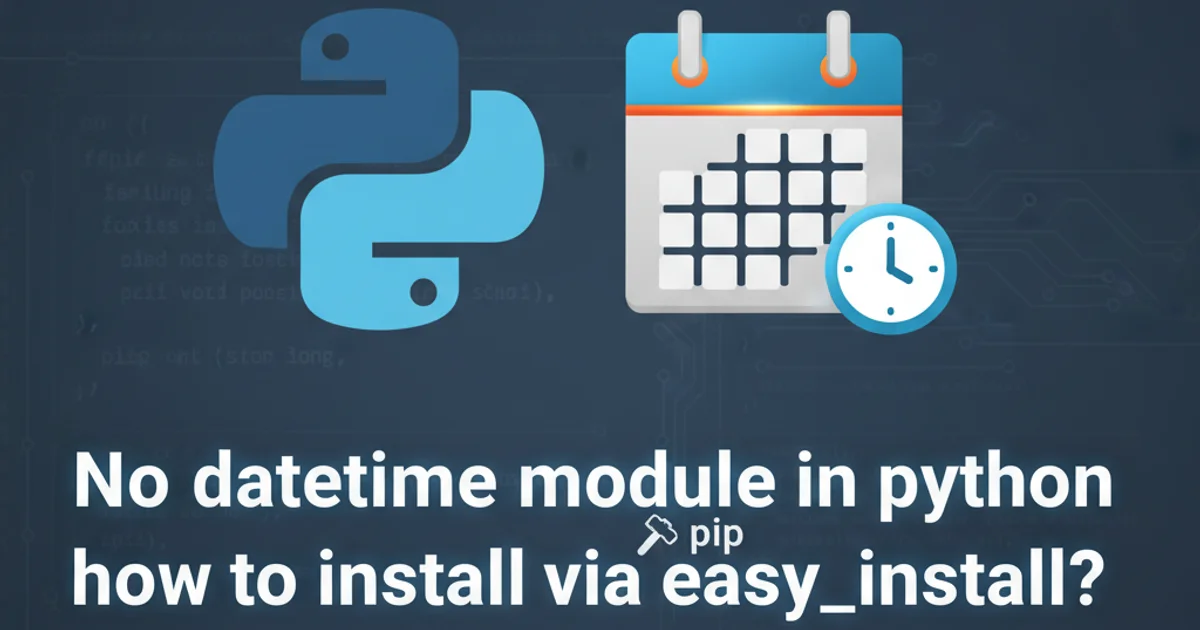No datetime module in python how to install via easy_install?
Categories:
Installing Python's datetime Module: A Guide for Easy_install Users

This article addresses common issues when trying to install the datetime module in Python, particularly for users accustomed to easy_install, and clarifies its built-in nature.
Many new Python developers, especially those coming from other languages or environments, might encounter a situation where they believe a core module like datetime is missing and needs to be installed. This often leads to attempts to use package managers like easy_install or pip for its installation. However, datetime is a fundamental, built-in module in Python's standard library, meaning it's always available and does not require separate installation.
Understanding Python's Standard Library
Python's standard library is a vast collection of modules that are included with every Python installation. These modules provide a wide range of functionalities, from file I/O and network communication to mathematical operations and, of course, date and time handling. The datetime module is a prime example of such a module. It offers classes for manipulating dates and times in both simple and complex ways, including date, time, datetime, timedelta, and tzinfo.
flowchart TD
A[Python Installation] --> B{Standard Library}
B --> C[Built-in Modules]
C --> D["datetime module"]
D --"No external installation needed"--> E[Ready to Use]
F[User attempts easy_install datetime] --> G{Error/Confusion}
G --> H["Realization: datetime is built-in"]
H --> EFlowchart illustrating the built-in nature of the datetime module
Why easy_install datetime Fails (or is Unnecessary)
When you try to install datetime using easy_install (or pip), you'll typically encounter one of two scenarios:
- "No local packages or download links found for datetime": This is the most common outcome. Package managers search for packages on repositories like PyPI (Python Package Index). Since
datetimeis not an external package, it's not listed there, and the installation attempt fails. - Successful 'installation' of a similarly named, unrelated package: In rare cases, there might be an obscure, unrelated package on PyPI named
datetime(or something very similar). Installing this would not give you the standarddatetimefunctionality and could lead to confusion or conflicts. This is why it's crucial to understand what you're trying to install.
The core reason for these outcomes is that datetime is already part of your Python environment. You simply need to import it.
Correct Usage: Importing the datetime Module
To use the datetime module, you simply need to import it at the beginning of your Python script or interactive session. There's no installation step required. Here are some common ways to import and use it:
import datetime
# Get the current date and time
now = datetime.datetime.now()
print(f"Current datetime: {now}")
# Create a specific date
my_date = datetime.date(2023, 10, 26)
print(f"My date: {my_date}")
# Create a specific time
my_time = datetime.time(14, 30, 0)
print(f"My time: {my_time}")
# Calculate a timedelta
two_weeks = datetime.timedelta(weeks=2)
future_date = now + two_weeks
print(f"Two weeks from now: {future_date}")
Basic usage of the datetime module after importing it.
Troubleshooting: When import datetime Fails
If import datetime itself fails, it's usually indicative of a more fundamental problem with your Python installation, rather than a missing datetime module. Here are a few things to check:
- Python Installation Integrity: Ensure your Python installation is not corrupted. Reinstalling Python might resolve this.
- Environment Variables: Verify that your system's
PATHenvironment variable correctly points to your Python executable. - Conflicting Files: Check if you have a file named
datetime.pyin your current working directory or on your Python path. If so, Python might be trying to import your local file instead of the standard library module, leading to errors. Rename or remove any such conflicting files. - Virtual Environments: If you're using a virtual environment, ensure it's activated correctly.
datetime.py or any other name that conflicts with standard library modules. This can lead to ImportError or unexpected behavior.1. Verify Python Installation
Open your terminal or command prompt and type python --version (or python3 --version). Ensure Python is installed and accessible.
2. Check for Conflicting Files
Navigate to the directory where your Python script is located. Look for any files named datetime.py. If found, rename it to something else (e.g., my_datetime_script.py).
3. Attempt Import in Interpreter
Open a Python interactive shell by typing python (or python3) in your terminal. Then, type import datetime and press Enter. If no error occurs, the module is available.
4. Reinstall Python (if necessary)
If all else fails and import datetime still produces an error, consider reinstalling Python from the official website (python.org) to ensure a clean and complete installation.